Options Margin Requirements

Options Margin Overview
US Options Margin Requirements
For residents of the United States trading options:
- Rules-based margin
- Portfolio margin
The complete margin requirement details are listed in the sections below.
The following calculations apply only to Margin, IRA Margin and Cash or IRA Cash. See our Portfolio Margin section for US Options requirements in a Portfolio Margin account.
FINRA and the NYSE have imposed rules to limit small investor day trading. Customers that these organizations classify as Pattern Day Traders are subject to special Day Trading Restrictions for U.S. securities.
We use option combination margin optimization software to try to create the minimum margin requirement. However, due to the system requirements required to determine the optimal solution, we cannot always guarantee the optimal combination in all cases. Please note that we do not support option exercises, assignments or deliveries which may result in an account being non-compliant with margin requirements. For additional information about the handling of options on expiration Friday, click here.
Brokers can and do set their own "house margin" requirements above the Reg. T or statutory minimum. For option spreads in VIX securities, we may charge an additional minimum house margin requirement of USD 150. For option positions that meet the definition of a "universal" spread under CBOE Rule 10.3(a)(5), we may charge an additional house requirement of 102% of the net maximum market loss associated with the spread (i.e., net long option position price – net short option position price * 102%), if greater than the statutory requirement.
Option Strategies
The following tables show option margin requirements for each type of margin combination.
Note:
These formulas make use of the functions Maximum (x, y, ..), Minimum (x, y, ..) and If (x, y, z). The Maximum function returns the greatest value of all parameters separated by commas within the paranthesis. As an example, Maximum (500, 2000, 1500) would return the value 2000. The Minimum function returns the least value of all parameters separated by commas within the paranthesis. As an example, Minimum (500, 2000, 1500) would return the value of 500. The If function checks a condition and if true uses formula y and if false formula z. As an example If (20 < 0, 30, 60) would return the value 60.
Clients must have an account net liquidation value of at least USD 2,000 to establish or increase an existing uncovered options position.
Long Call or Put
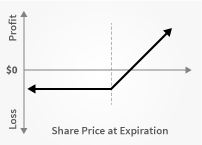
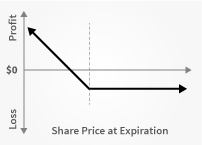
| Margin | |
| Initial/RegT End of Day Margin | None |
| Maintenance Margin | Same as Initial |
| Cash or IRA Cash | Same as Initial |
| IRA Margin | Same as Margin Account |
Short Naked Call
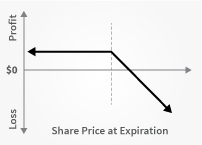
| Margin | |
| Initial/RegT End of Day Margin |
Stock Options 1 Call Price + Maximum ((20% 2 * Underlying Price - Out of the Money Amount), (10% * Underlying Price)) Index Options 1 Call Price + Maximum ((15% 3 * Underlying Price - Out of the Money Amount), (10% * Underlying Price)) World Currency Options 1 Call Price + Maximum ((4% 2 * Underlying Price - Out of the Money Amount), (0.75% * Underlying Price)) Cash Basket Option 1 In the Money Amount |
| Maintenance Margin | Same as Initial |
| Cash or IRA Cash | N/A |
| IRA Margin | Same as Cash Account |
Short Naked Put
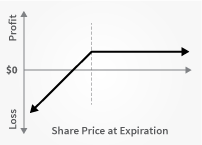
| Margin | |
| Initial/RegT End of Day Margin |
Stock Options 1 Put Price + Maximum ((20% 2 * Underlying Price - Out of the Money Amount), (10% * Strike Price)) Index Options 1 Put Price + Maximum ((15% 3 * Underlying Price - Out of the Money Amount), (10% * Strike Price)) World Currency Options 1 Put Price + Maximum ((4% 2 * Underlying Price - Out of the Money Amount), (0.75% * Underlying Price)) Cash Basket Option 1 In the Money Amount |
| Maintenance Margin | Same as Initial |
| Cash or IRA Cash | Put Strike Price |
| IRA Margin | Same as Cash Account |
Covered Calls
Short an option with an equity position held to cover full exercise upon assignment of the option contract.
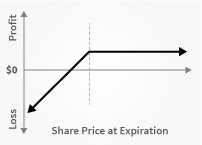
| Margin | |
| Initial/RegT End of Day Margin | Max(Call Value, Long Stock Initial Margin) |
| Maintenance Margin | MAX[In-the-money amount + Margin(long stock evaluated at min(mark price, strike(short call))), min(stock value, max(call value, long stock margin))] |
| Cash or IRA Cash | Stock paid in full or None |
| IRA Margin | Stock paid in full or None |
Covered Puts
Short an option with an equity position held to cover full exercise upon assignment of the option contract.
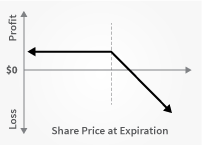
| Margin | |
| Initial/RegT End of Day Margin | Initial Stock Margin Requirement + In the Money Amount |
| Maintenance Margin | Initial Stock Margin Requirement + In the Money Amount |
| Cash or IRA Cash | N/A |
| IRA Margin | N/A |
Call Spread
A long and short position of equal number of calls on the same underlying (and same multiplier) if the long position expires on or after the short position.
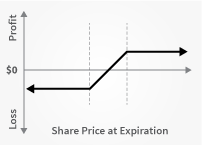
| Margin | |
| Initial/RegT End of Day Margin | Maximum (Strike Long Call - Strike Short Call, 0) |
| Maintenance Margin | Same as Initial |
| Cash or IRA Cash | Same as Initial if both options are European-style cash-settled Otherwise, N/A. |
| IRA Margin | Same as Margin Account |
Put Spread
A long and short position of equal number of puts on the same underlying (and same multiplier) if the long position expires on or after the short position.
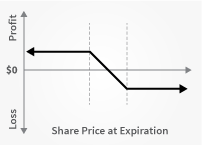
| Margin | |
| Initial/RegT End of Day Margin | Maximum (Short Put Strike - Long Put Strike, 0) |
| Maintenance Margin | Same as Initial |
| Cash or IRA Cash | Same as Margin Account (Both options must be European style cash settled) Short Put Strike Price (American style options) |
| IRA Margin | Same as Margin Account |
Collar
Long put and long underlying with short call. Put and call must have same expiration date, same underlying (and same multiplier), and put exercise price must be lower than call exercise price.

| Margin | |
| Initial/RegT End of Day Margin | Initial Stock Margin Requirement + In the Money Call Amount Equity with Loan Value of Long Stock Minimum (Current Market Value, Call Aggregate Exercise Price) |
| Maintenance Margin | Minimum (((10% * Put Exercise Price) + Out of the-Money Put Amount), (25% * Call Exercise Price)) |
| Cash or IRA Cash | None |
| IRA Margin | None |
Long Call and Put
Buy a call and a put.
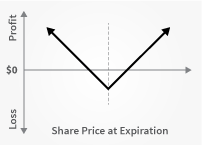
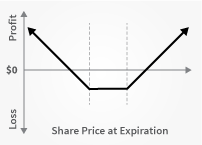
| Margin | |
| Initial/RegT End of Day Margin | Margined as two long options. |
| Maintenance Margin | Same as Initial |
| Cash or IRA Cash | Same as Margin Account |
| IRA Margin | Same as Margin Account |
Short Call and Put
Sell a call and a put.
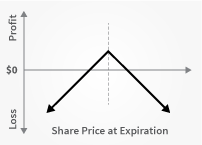
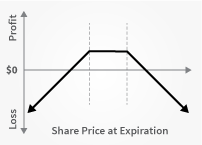
| Margin | |
| Initial/RegT End of Day Margin |
If Initial Margin Short Put > Initial Short Call, then Initial Margin Short Put + Price Short Call else If Initial Margin Short Call >= Initial Short Put, then Initial Margin Short Call + Price Short Put |
| Maintenance Margin | Same as Initial |
| Cash or IRA Cash | N/A |
| IRA Margin | N/A |
Long Butterfly
Two short options of the same series (class, multiplier, strike price, expiration) offset by one long option of the same type (put or call) with a higher strike price and one long option of the same type with a lower strike price. All component options must have the same expiration, same underlying, and intervals between exercise prices must be equal.
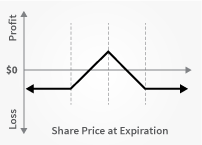
| Margin | |
| Initial/RegT End of Day Margin | None |
| Maintenance Margin | Same as Initial |
| Cash or IRA Cash | None Both options must be European-style cash-settled. |
| IRA Margin | Same as Margin Account |
Short Butterfly Put
Two long put options of the same series offset by one short put option with a higher strike price and one short put option with a lower strike price. All component options must have the same expiration, same underlying, and intervals between exercise prices must be equal.
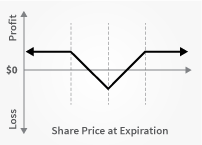
| Margin | |
| Initial/RegT End of Day Margin | MAX(Highest Put Strike - Middle Put Strike, 0) + MAX(Lowest Put Strike - Middle Put Strike, 0) |
| Maintenance Margin | Same as Initial |
| Cash or IRA Cash | N/A |
| IRA Margin | N/A |
Short Butterfly Call
Two long call options of the same series offset by one short call option with a higher strike price and one short call option with a lower strike price. All component options must have the same expiration, same underlying, and intervals between exercise prices must be equal.

| Margin | |
| Initial/RegT End of Day Margin | MAX(Middle Call Options Strike - High Call Options Strike, 0) + MAX(Middle Call Options Strike - Lowest Call Option Strike, 0) |
| Maintenance Margin | Must maintain initial margin. |
| Cash or IRA Cash | N/A |
| IRA Margin | N/A |
Long Box Spread
Long call and short put with the same exercise price ("buy side") coupled with a long put and short call with the same exercise price ("sell side"). Buy side exercise price is lower than the sell side exercise price. All component options must have the same expiration, and underlying (multiplier).
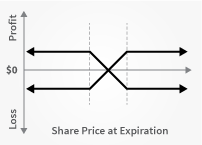
| Margin | |
| Initial/RegT End of Day Margin | None |
| Maintenance Margin | Same as Initial |
| Cash or IRA Cash | N/A |
| IRA Margin | Same as Margin Account |
Short Box Spread
Long call and short put with the same exercise price ("buy side") coupled with a long put and short call with the same exercise price ("sell side"). Buy side exercise price is higher than the sell side exercise price. All component options must have the same expiration, and underlying (multiplier).

| Margin | |
| Initial/RegT End of Day Margin | MAX(1.02 x cost to close, Long Call Strike – Short Call Strike) |
| Maintenance Margin | Same as Initial |
| Cash or IRA Cash | N/A |
| IRA Margin | Same as Margin Account |
Conversion
Long put and long underlying with short call. Put and call must have the same expiration date, underlying (multiplier), and exercise price.
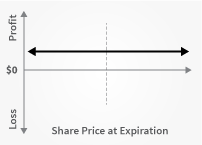
| Margin | |
| Initial/RegT End of Day Margin | Initial Stock Margin Requirement + In the Money Call Amount |
| Maintenance Margin | 10% of the strike price + In the Money Call Amount |
| Cash or IRA Cash | N/A |
| IRA Margin | N/A |
Reverse Conversion
Long call and short underlying with short put. Put and call must have same expiration date, underlying (multiplier), and exercise price.

| Margin | |
| Initial/RegT End of Day Margin | In the Money Put Amount + Initial Stock Margin Requirement |
| Maintenance Margin | In the Money Put Amount + (10% * Strike Price) |
| Cash or IRA Cash | N/A |
| IRA Margin | N/A |
Protective Put
Long Put and Long Underlying.
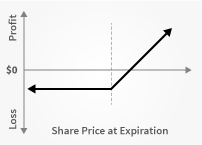
| Margin | |
| Initial/RegT End of Day Margin | Initial Stock Margin Requirement |
| Maintenance Margin | Minimum (((10% * Put Strike Price) + Put Out of the Money Amount), Long Stock Maintenance Requirement) |
| Cash or IRA Cash | None |
| IRA Margin | None |
Protective Call
Long Call and Short Underlying.
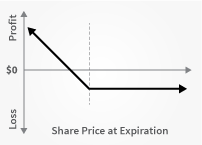
| Margin | |
| Initial/RegT End of Day Margin | Initial Standard Stock Margin Requirement |
| Maintenance Margin | Minimum (((10% * Call Strike Price) + Call Out of the Money Amount), Short Stock Maintenance Requirement) |
| Cash or IRA Cash | N/A |
| IRA Margin | N/A |
Iron Condor
Sell a put, buy put, sell a call, buy a call.
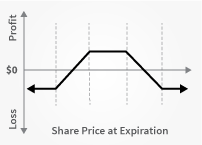
| Margin | |
| Initial/RegT End of Day Margin | Short Put Strike - Long Put Strike |
| Maintenance Margin | Same as Initial |
| Cash or IRA Cash | If all options are European and cash-settled, same as margin account. |
| IRA Margin | Same as Margin Account |

Overview of Pattern Day Trading ("PDT") Rules
FINRA and the NYSE have instituted regulations intended to limit the amount of trading that can be done in accounts with small amounts of capital, specifically accounts with less than USD 25,000 Net Liquidation Value.
Pattern
Day Trader
Pattern
Day Trader
Mon
Tues
Wed
Thurs
Fri
Sell XXZ
Sell ZZX
Sell YYZ
Sell YYZ
- Day Trade: any trade pair wherein a position in a security (Stocks, Stock and Index Options, Warrants, T-Bills, Bonds, or Single Stock Futures) is increased ("opened") and thereafter decreased ("closed") within the same trading session.
- Pattern Day Trader: someone who effects 4 or more Day Trades within a 5 business day period. A trader who executes 4 or more day trades in this time is deemed to be exhibiting a ‘pattern’ of day trading and is thereafter subject to the PDT restrictions.
- In order to day trade, the account must have at least USD 25,000 in Net Liquidation Value, where Net Liquidation Value includes cash, stocks, options, and futures P+L.
- We have created algorithms to prevent small accounts from being flagged as day trading accounts. We implement this by prohibiting the 4th opening transaction within 5 days if the account has less than USD 25,000 in equity.
Adjustments to Previous Day's Equity and First Day Trading
The previous day's equity is recorded at the close of the previous day (4:15 PM ET). Previous day's equity must be at least USD 25,000. However, net deposits and withdrawals that brought the previous day's equity up to or greater than the required USD 25,000 after 4:15 PM ET on the previous trading day are handled as adjustments to the previous day's equity, so that on the next trading day, the customer is able to trade.
For example, suppose a new customer's deposit of USD 50,000 is received after the close of the trading day. Even though his previous day's equity was 0 at the close of the previous day, we handle the previous day's late deposit as an adjustment, and this customer's previous day equity is adjusted to USD 50,000 and he is able to trade on the first trading day. Without this adjustment, the customer's trades would be rejected on the first trading day based on the previous day's equity recorded at the close.
Special Cases
- Accounts that at one time had more than USD 25,000, were identified as accounts with day trading activity, and thereafter the Net Liquidation Value in the account dropped below USD 25,000, may find themselves subject to the 90 day trading restriction. The restrictions can be lifted by increasing the equity in the account or following the release procedure located in the Day Trading FAQ section.
- The proceeds of an option exercise or assignment will count towards day trading activity as if the underlying had been traded directly. Deliveries from single stock futures or lapse of options are not considered part of a day trading activity.
Additional details relating to PDT regulations and our implementation of these rules can be found in the FAQ section.

Day Trading FAQs
FINRA defines a Pattern Day Trader (PDT) as one who effects four or more day trades (same day opening and closing of a given equity security ("stock") or equity option) within a five business day period.
Note that Futures contracts and Futures Options are not included in the SEC Day Trade rule.
A potential pattern day trader error message means that an account has less than the SEC required USD 25,000 minimum Net Liquidation Value AND the number of available day trades (3) has already been used within the last five days.
The system is programmed to prohibit any further trades to be initiated in the account, regardless of the intent to day trade that position or not. The system is programmed to protect the accounts with less than USD 25,000 so the account would not "potentially" be flagged as a day trading account.
If an account receives the error message "potential pattern day trader", there is no PDT flag to remove. The account holder will need to wait for the five-day period to end before any new positions can be initiated in the account.
The customer has the following options:
- Deposit funds to bring the account's equity up to the SEC required minimum of USD 25,000
- Request a PDT account reset (if available)
If the intraday situation occurs, the customer will immediately be prohibited from initiating any new positions. Customers should be able to close any existing positions in his account, but will not be allowed to initiate any new positions.
The customer will have the same options listed above, however, if at any time the Net Liquidation Value figure goes back above the threshold amount ($25,000), then the account will once again have day trades available.
FINRA has provided brokerage firms the ability to remove the PDT flag from a customer's account once, upon a good faith determination that the customer will no longer engage in pattern day trading. If an account was erroneously flagged, and the customer's intent is not to day trade in his/her account, we have the ability to remove this flag.
FINRA defines a Pattern Day Trader (PDT) as one who effects 4 or more day trades (same day purchase and sale of a given equity security ("stock") or equity option) within a five-day period, and FINRA rules place certain restrictions on those who are deemed to be pattern day traders. If a customer account effects three (3) day trades involving stocks or equity options within any five (5) day period, we will require that such account satisfy the minimum Net Liquidation Value requirement of USD 25,000 before we will accept the next order to purchase or sell a stock or equity option. Once the account has effected a fourth day trade (in such 5 day period), we will deem the account to be a PDT account.
Pattern Day Trading regulations allow a broker to remove the PDT designation, one time only, if the client acknowledges that she/he does not intend to engage in day trading strategies, and requests that the PDT designation be removed. If you wish to have the PDT designation for your account removed, provide us with the following acknowledgement using the online PDT request tool.
- I agree to the following:
- I do not intend to engage in a day trading strategy in my account.
- I hereby request that you the broker no longer designate my account as a "Pattern Day Trading" account under FINRA rules.
- I understand that if, following this acknowledgement I engage in Pattern Day Trading, my account will be designated as a Pattern Day Trading" account, and you the broker will apply all applicable PDT rules to my account.
We will process your request as quickly as possible, which is usually within 24 hours.
For example, if the window reads (0,0,1,2,3), here is how to interpret this information:
If today was Wednesday, the first number within the parenthesis, 0, means that 0-day trades are available on Wednesday. The 2nd number in the parenthesis, 0, means that no day trades are available on Thursday. The 3rd number within the parenthesis, 1, means that on Friday 1-day trade is available. The 4th number within the parenthesis, 2, means that on Monday, if 1-day trade was not used on Friday, and then on Monday, the account would have 2-day trades available. The 5th number within the parenthesis, 3, means that if no day trades were used on either Friday or Monday, then on Tuesday, the account would have 3-day trades available.

Portfolio Margin
Under SEC-approved Portfolio Margin rules and using our real-time margin system, our customers are able in certain cases to increase their leverage beyond Reg T margin requirements. For decades margin requirements for securities (stocks, options and single stock futures) accounts have been calculated under a Reg T rules-based policy. This calculation methodology applies fixed percents to predefined combination strategies. With Portfolio Margin, margin requirements are determined using a "risk-based" pricing model that calculates the largest potential loss of all positions in a product class or group across a range of underlying prices and volatilities. This model, known as the Theoretical Intermarket Margining System ("TIMS"), is applied each night to U.S. stocks, OCC stock and index options and U.S. single stock futures positions by the federally-chartered Options Clearing Corporation("OCC") and is disseminated by the OCC to participating brokerage firms each night. The minimum margin requirement in a Portfolio Margin account is static during the day because the OCC only disseminates the TIMS parameter requirements once per day.
However, Portfolio Margin compliance is updated by us throughout the day based on the real-time price of the equity positions in the Portfolio Margin account. Please note, at this time, Portfolio Margin is not available for U.S. commodities futures and futures options, U.S. bonds, Mutual Funds, or Forex positions, but U.S. regulatory bodies may consider inclusion of these products at a future date.
Portfolio or risk based margin has been utilized for many years in both commodities and many non-U.S. securities markets, with great success. Dependent upon the composition of the trading account, Portfolio Margin may require a lower margin than that required under Reg T rules, which translates to greater leverage. Trading with greater leverage involves greater risk of loss. There is also the possibility that, given a specific portfolio composed of positions considered as having higher risk, the requirement under Portfolio Margin may be higher than the requirement under Reg T. Part of the reasoning behind the creation of Portfolio Margin is that the margin requirements would more accurately reflect the actual risk of the positions in an account. Thus, it is possible that, in a highly concentrated account, a Portfolio Margin approach may result in higher margin requirements than under Reg T. One of the main goals of Portfolio Margin is to reflect the lower risk inherent in a balanced portfolio of hedged positions. Conversely, Portfolio Margin must assess proportionately larger margin for accounts with positions which represent a concentration in a relatively small number of stocks.
Portfolio Margin Eligibility
Customers must meet the following eligibility requirements to open a Portfolio Margin account:
- An existing account must have at least USD 110,000 (or USD equivalent) in Net Liquidation Value to be eligible to upgrade to a Portfolio Margin account (in addition to being approved for uncovered option trading). Existing customers may apply for a Portfolio Margin account on the Account Type page in Account Management at any time and your account will be upgraded upon approval. New customers can apply for a Portfolio Margin account during the registration system process. It should be noted that if your account drops below USD 100,000 you will be restricted from doing any margin-increasing trades. Therefore if you do not intend to maintain at least USD 100,000 in your account, you should not apply for a Portfolio Margin account.
- New customer accounts requesting Portfolio Margin may take up to 2 business days (under normal business circumstances) to have this capability assigned after initial account approval. It should be noted that if your account is subsequently funded with less than USD 100,000 in Net Liquidation Value (or USD equivalent), you will be restricted from doing any margin-increasing trades until the Net Liquidation Value exceeds USD 100,000. Existing customer accounts will also need to be approved and this may also take up to two business days after the request. Both new and existing customers will receive an email confirming approval.
- Those institutions who wish to execute some trades away from us and use us as a prime broker will be required to maintain at least USD 6,000,000 (or USD equivalent).
- Customers in Canada are not eligible for Portfolio Margin accounts due to IDA restrictions. In addition, all Canadian stock, stock options, index options, European stock, and Asian stock positions will be calculated under standard rules-based margin rules so Portfolio Margin will not be available for these products.
- Non-U.S. Omnibus Broker (Long Position/Short Position) accounts are not eligible for Portfolio Margin accounts.
- Accounts reporting equity below the USD 100,000 minimum will be subject to a margin surcharge, the effect of which will be to gradually transition the account to margin levels approximating those of the Reg. T methodology as equity continues to decline.
Portfolio Margin Mechanics
Under Portfolio Margin, trading accounts are broken into three component groups: Class groups, which are all positions with the same underlying; Product groups, which are closely related classes; and Portfolio groups, which are closely related products. Examples of classes would include IBM, SPX, and OEX. A product example would be a Broad Based Index composed of SPX, OEX, etc. A portfolio could include such products as Broad Based Indices, Growth Indices, Small Cap Indices, and FINRA Indices.
The portfolio margin calculation begins at the lowest level, the class. All positions with the same class are grouped and stressed (underlying price and implied volatility are changed) together with the following parameters:
- A standardized stress of the underlying.
- For stock, equity options, narrow based indices and single stock futures, the stress parameter is plus or minus 15%, with eight other points within that range.
- For U.S. market small caps and FINRA market indices the stress parameter is plus 10%, minus 10% as well as eight other points in-between.
- For Broad Based Indices and Growth indices the stress parameter is plus 6%, minus 8% as well as eight other points in-between.
- A market-based stress of the underlying based on historical moves in Bloomberg pricing data.
- For Broad Based Indices the implied volatility factor is increased 75% and decreased by 75%.
- For all other classes, the implied volatility for each options class is increased by 150% and decreased by 150%
In addition to the stress parameters above the following minimums will also be applied:
- Classes with large single concentrations will have a margin requirement of 30% applied to the concentrated position.
- A USD 0.375 multiplied by the index per contract minimum is computed.
- The same special margin requirements for OTCBB, Pink Sheet and low cap stocks that apply under Reg T, will still apply under Portfolio Margin.
- Initial margin will be 110% of Maintenance Margin.
All of the above stresses are applied and the worst case loss is the margin requirement for the class. Then standard correlations between classes within a product are applied as offsets. As an example, within the Broad Based Index product 90% offset is allowed between SPX and OEX. Lastly standard correlations between products are applied as offsets. An example would be a 50% offset between Broad Based Indices and Small Cap Indices. For stocks and Single Stock Futures offsets are only allowed within a class and not between products and portfolios. After all the offsets are taken into account all the worst case losses are combined and this number is the margin requirement for the account. For a complete list of products and offsets, see the Appendix-Product Groups and Stress Parameters section at the end of this document.
Our real-time, intra-day margining system enables us to apply the Day Trading Margin Rules to Portfolio Margin accounts based on real-time equity, so Pattern Day Trading Accounts will always be able to trade based on their full, real-time buying power.
Because of the complexity of Portfolio Margin calculations it would be extremely difficult to calculate margin requirements manually. We encourage those interested in Portfolio Margin to use our TWS Portfolio Margin Demo to understand the impact of Portfolio Margin requirement under different scenarios.
Click here for the OCC's published list of Product Groups and Offset Parameters.
Additional US Margin Requirements
For Residents of the United States:
Use the following links to view other margin requirements:
You can change your location setting by clicking here
Disclosures
- Minimum charge of USD 2.50 per share of underlying. This minimum does not apply for End of Day Reg T calculation purposes.
- For Leverage Options, Minimum (20% * Leverage Factor, 100%).
- For Leverage Options, Minimum (15% * Leverage Factor, 100%)
- For Covered Basket Calls, (short basket call, long component stocks), the margin requirement is for all the component stocks.
- Specific options with commodity-like behavior, such as VIX Index Options, have special spread rules and, consequently, may be required to meet higher margin requirements than a straightforward US equity option. Clients are urged to use the paper trading account to simulate an options spread in order to check the current margin on such spread.
- If a combination of options is put on in such a way that a specific strategy is optimal at that point in time, the strategy may remain in place until the account is revalued even if it does not remain the optimal strategy. A revaluation will occur when there is a position change within that symbol. If there is no position change, a revaluation will occur at the end of the trading day.
- Interactive Brokers Australia currently offers margin lending to all clients EXCEPT Self- managed Superannuation Fund account holders ("SMSF"). Click here for more information. For clients of Interactive Brokers Australia who are classified as retail, margin loans will be capped at AUD 50,000 (subject to change in IBKR Australia’s sole discretion). Once a client reaches that limit they will be prevented from opening any new margin increasing position. However, how much a client can borrow depends on a number of factors, including: the value of the money or assets contributed by the client as security; which financial products the client chooses to invest in, as we lend different amounts for different products under our risk-based model; and the maintenance margin requirement for the client’s portfolio. Once a client reaches their borrowing limit they will be prevented from opening any new margin increasing position. Closing or margin-reducing trades will be allowed. Refer to this link for information regarding margin accounts offered by IBKR Australia.
- IBKR house margin requirements may be greater than rule-based margin.